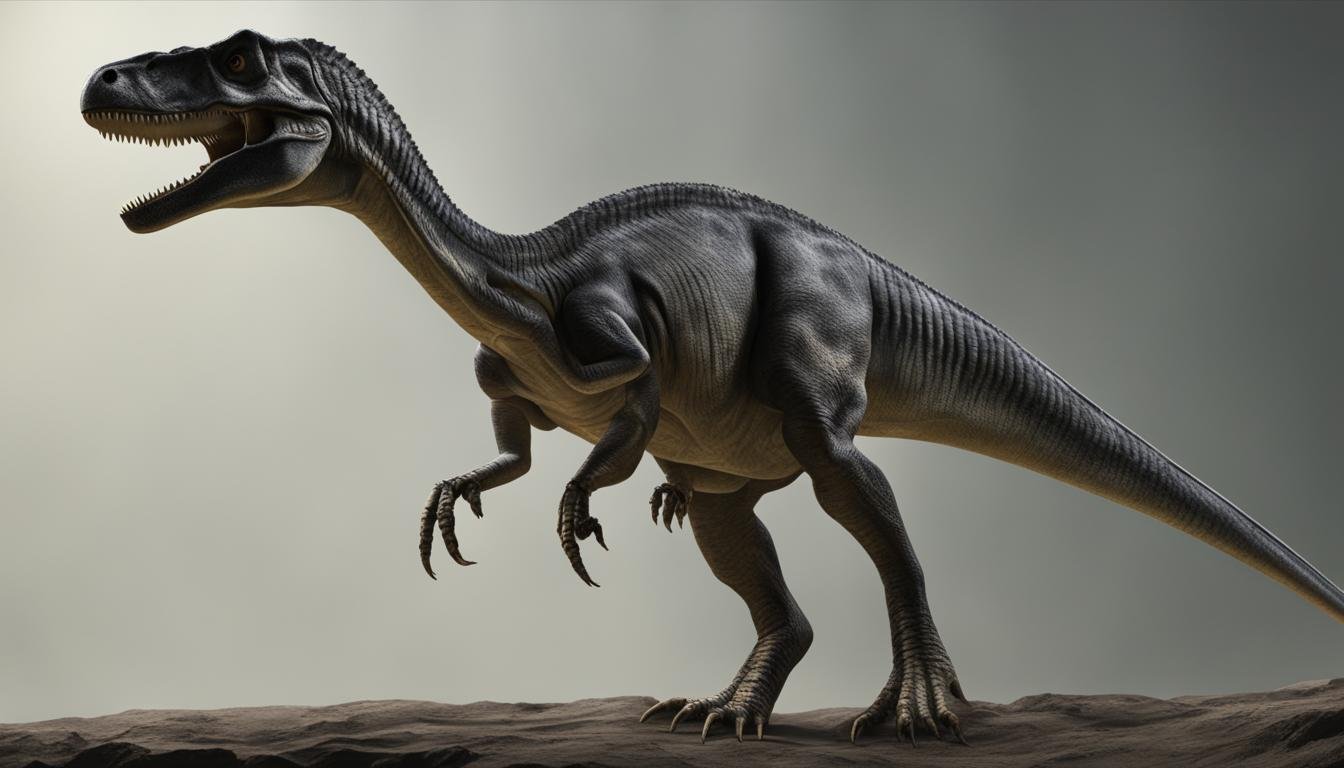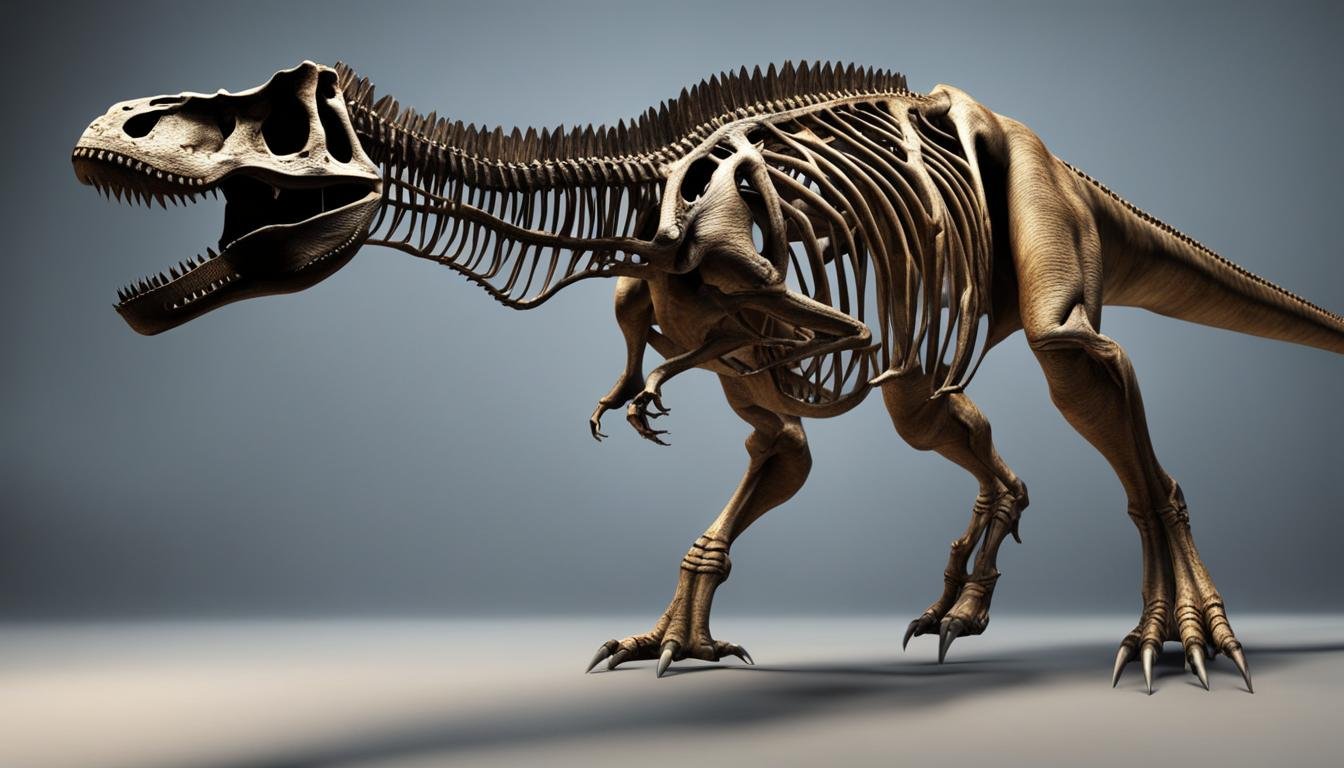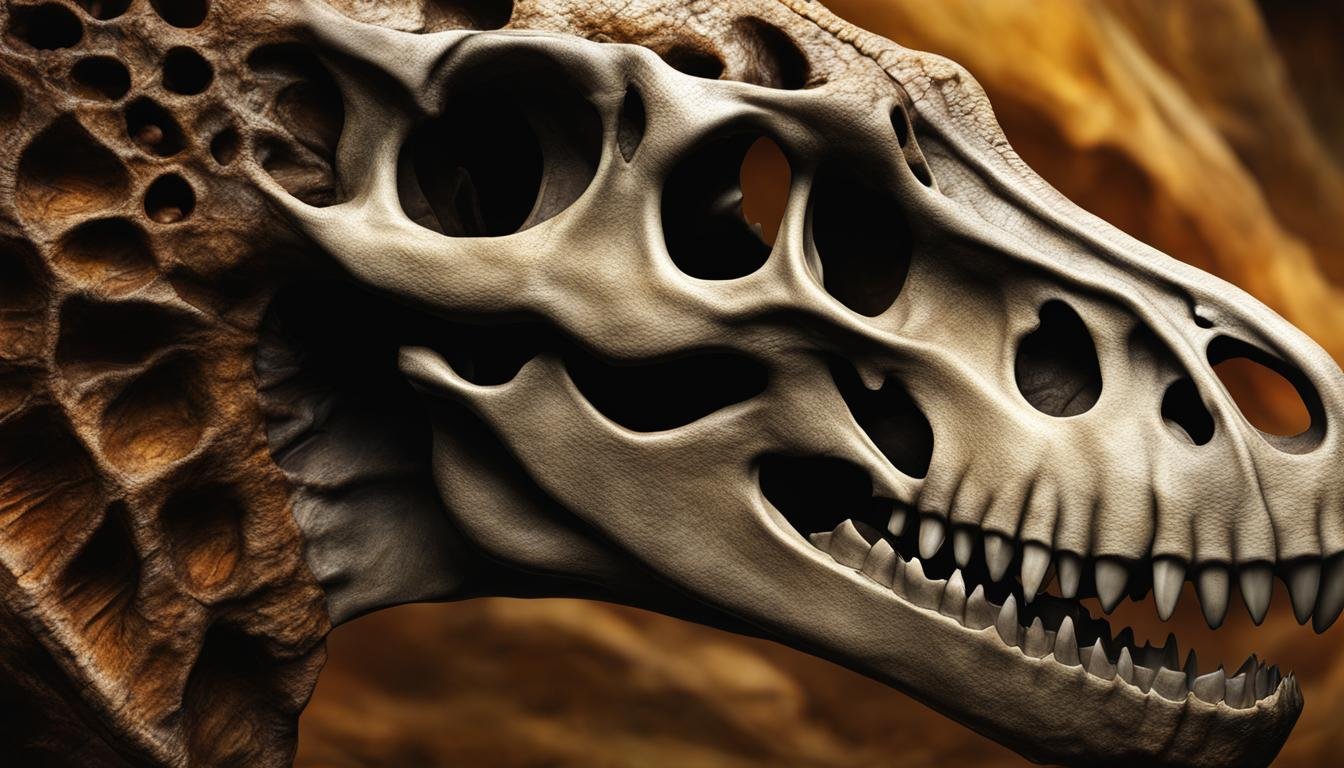Welcome to our exploration of dinosaur skin! In this article, we will delve into the fascinating world of dinosaur epidermis and discover the remarkable facts behind their scales. From pigmentation to feathers, we will uncover the secrets hidden within their dermis and unravel the mysteries of their ancient skin.
Evidence of Scales in Dinosaur Skin
Paleontologists have uncovered fascinating evidence of scales in dinosaur skin through the discovery of fossilized skin impressions. These impressions closely resemble the scales found in modern reptiles like crocodiles and lizards. By studying these skin impressions and comparing them to living animals, scientists can gain valuable insights into the types of scales that dinosaurs possessed.
One important component of dinosaur scales is keratin, a protein that is also present in reptile skin. Keratin provides strength and flexibility to the scales, allowing them to withstand the rigors of daily life. Additionally, collagen, another protein, has been found in fossilized dinosaur skin. Collagen is responsible for the structure and elasticity of the skin.
These findings suggest that dinosaurs had a similar skin structure to reptiles, with scales composed of keratin and collagen. This indicates that dinosaurs may have had a reptilian-like outer covering rather than smooth skin like mammals or feathers like birds. The presence of scales in dinosaur skin adds another layer of complexity to our understanding of these ancient creatures.
| Types of Scales | Examples of Dinosaurs |
|---|---|
| Imbricate scales | Stegosaurus, Triceratops |
| Round scales | Tyrannosaurus rex, Allosaurus |
| Plate-like scales | Ankylosaurus, Euoplocephalus |
The discovery of scales in dinosaur skin provides valuable insights into the physical characteristics and adaptations of these prehistoric creatures. It helps us visualize how dinosaurs may have appeared and interacted with their environment. By studying these remarkable skin impressions, scientists continue to uncover remarkable details about the ancient world of dinosaurs.
Feathers in Dinosaurs
The discovery of feathers in dinosaurs has revolutionized our understanding of these ancient creatures. While it was once believed that only certain groups of dinosaurs had feathers, recent findings have revealed that many dinosaurs, including some meat-eating theropods, had feathers or proto-feathers. These feathered dinosaurs provide a crucial link between the reptilian ancestors of birds and modern-day avian species.
Feather evolution in dinosaurs was a gradual process, with proto-feathers likely being simple, filamentous structures that were primarily used for warmth. As dinosaurs evolved, feathers became more complex and served additional functions such as colorful displays for courtship, communication, and even enhanced aerodynamics for those dinosaurs capable of flight. These feathered adornments would have added a striking visual spectacle to the prehistoric landscape.
One of the most remarkable examples of feathered dinosaurs is the iconic Archaeopteryx. This ancient bird-like dinosaur exhibits clear evidence of feathers, with well-preserved impressions found on its wings and tail. These feathered structures closely resemble those of modern bird feathers, providing a fascinating glimpse into the evolution of flight and the origins of avian features.
The Connection to Bird Ancestors
The presence of feathers in dinosaurs also strengthens the connection between dinosaurs and their bird ancestors. The similarities in feather structure and development between dinosaurs and birds suggest a shared evolutionary heritage. By studying the fossil record and comparing the characteristics of dinosaur feathers to those of modern birds, scientists can uncover valuable insights into the early stages of feather development and the emergence of flight.
The discovery of feathers in dinosaurs challenges the traditional perception of these ancient creatures. It not only adds a new dimension to their appearance but also provides clues about their behavior, communication, and adaptation to their environment. Understanding the evolution and function of feathers in dinosaurs opens up a world of possibilities for exploring the diverse range of prehistoric life that once roamed the Earth.
| Dinosaur Species | Feather Type | Feather Function |
|---|---|---|
| Tyrannosaurus rex | Possible proto-feathers | Insulation, display |
| Velociraptor | Feathered | Insulation, possibly limited flight |
| Archaeopteryx | Well-developed feathers | Flight, display |
| Deinonychus | Feathered | Insulation, possibly limited flight |
Coloration and Pattern Variation
One of the intriguing aspects of dinosaur skin is its coloration and pattern variation. Through the analysis of fossilized melanosomes, scientists can gain insights into the pigments produced by dinosaurs and the color patterns they exhibited. Melanosomes are organelles that generate pigment cells, and when they become fossilized, they provide valuable information about the coloration of dinosaurs.
By studying the pigments present in fossilized skin, researchers have determined that while some dinosaurs may have been more colorful, the majority were likely shades of brown, grey, and green. These earth-toned colors would have allowed dinosaurs to blend in with their environment, providing them with camouflage and helping them evade predators. Such coloration and pattern variation served as an adaptive advantage for survival in their ecosystems.
Additionally, it is believed that the pigmentation of dinosaur skin played a crucial role in other aspects of their lives. For example, some researchers suggest that the coloration and patterns could have been used for communication and mate attraction purposes. Just like how animals today use their vibrant colors to signal their readiness to mate or intimidate rivals, dinosaurs may have utilized their skin patterns and colors to convey similar messages.
“The coloration and pattern variation of dinosaur skin provided them with effective camouflage, allowing them to blend in with their surroundings and avoid predation.”
| Dinosaur Species | Coloration | Pattern |
|---|---|---|
| Tyrannosaurus Rex | Dark brown with patches of green | Mottled pattern |
| Triceratops | Light brown | Striped pattern |
| Stegosaurus | Gray with dark plates | Spotted pattern |
Skin Fossils and Paleodermatology
When it comes to understanding the appearance and characteristics of dinosaurs, fossilized skin is a precious find. These skin fossils provide invaluable insights into the structure, texture, and preservation of dinosaur skin, allowing scientists to study ancient epidermal structures and adaptations. The field of paleodermatology focuses on the study of these skin fossils, shedding light on the various functions and complexities of dinosaur skin.
Through the discovery and analysis of skin fossils, researchers have been able to identify the presence of scales and feathers in different dinosaur species. These findings have provided evidence of the evolutionary relationships between dinosaurs and modern reptiles and birds. By examining the epidermal structures, including the arrangement and composition of scales and feathers, scientists have been able to gain a better understanding of the integumentary system and how dinosaurs interacted with their environment.
The study of dinosaur skin provides valuable insights into their appearance, adaptations, and behaviors.
One remarkable aspect of skin preservation is the ability to observe the differences in skin texture and elasticity among various dinosaur species. Some dinosaurs exhibited smooth skin, while others had bumpy or even armored skin. These features not only played a role in haptic feedback, allowing dinosaurs to sense their environment through touch, but also provided additional protection against predators and environmental hazards.
| Dinosaur Species | Texture of Skin | Additional Features |
|---|---|---|
| Tyrannosaurus rex | Bumpy and scaly | Dermal armor for defense |
| Stegosaurus | Armored plates | Spikes for deterrence |
| Velociraptor | Smooth and feathery | Feathers for insulation and display |
The preservation of dinosaur skin is a rare occurrence due to the delicate nature of soft tissues. However, when skin fossils are found, they provide a wealth of information about the physical appearance and adaptations of these prehistoric creatures. The study of skin preservation in dinosaurs continues to unravel fascinating insights into their biology, enabling us to better visualize and understand the world they inhabited millions of years ago.
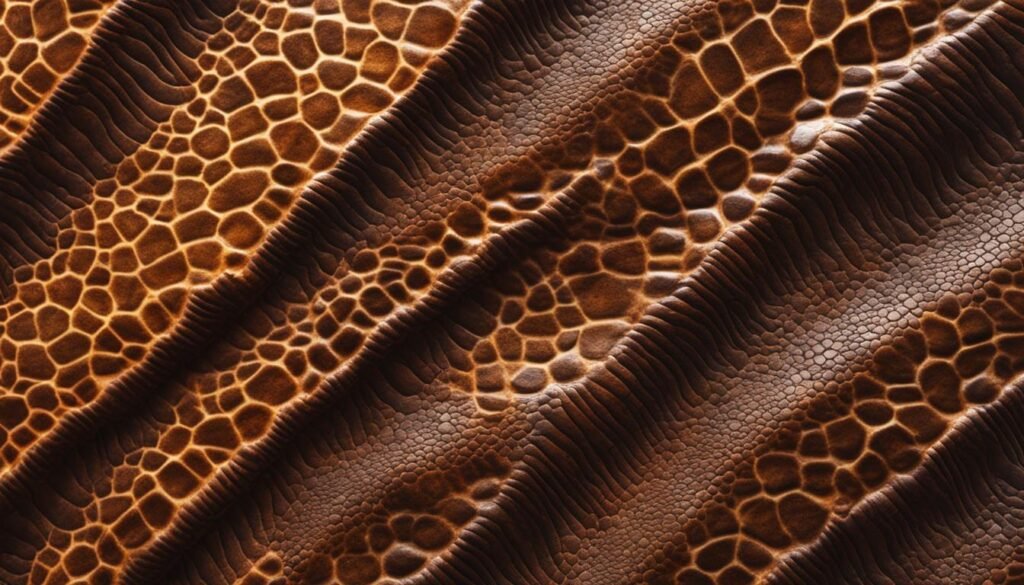
Epidermal Structures and Adaptations
One of the key areas of research in paleodermatology is the examination of epidermal structures and adaptations in dinosaur skin. By studying the microscopic details of skin fossils, scientists can identify the presence of specialized structures for various functions. These may include sensory receptors that allowed dinosaurs to detect their surroundings, as well as structures related to thermoregulation and waterproofing.
The epidermal adaptations in dinosaur skin reveal the remarkable diversity and complexity of these ancient creatures. From the scales of the fierce Tyrannosaurus rex to the intricate feathers of the agile Velociraptor, these epidermal structures played a vital role in the survival and success of different dinosaur species. The study of epidermal structures helps us piece together the puzzle of dinosaur evolution and better appreciate their incredible adaptations.
Skin Adaptations and Functions
Dinosaur skin featured a range of adaptations and functions that allowed these ancient creatures to thrive in their environments. From thermoregulation to protective covering, sensory perception to waterproofing, the skin played a crucial role in their survival.
Thermoregulation
Dinosaur skin, equipped with scales and feathers, helped regulate their body temperature. Just like modern reptiles, dinosaurs relied on their skin to absorb or reflect heat, depending on their needs. The arrangement and density of scales or feathers allowed for efficient heat exchange, keeping their bodies at the optimal temperature.
Protective Covering
The skin served as a protective barrier for dinosaurs, shielding them from predators and environmental hazards. Scales and strong dermal armor provided an additional layer of defense. These adaptations helped dinosaurs withstand physical trauma and protect their vital organs from external threats.
Sensory Receptors
Dinosaur skin was not just a passive barrier; it also contained sensory receptors that allowed them to navigate their surroundings. These receptors provided information about their environment through touch, allowing dinosaurs to detect potential dangers or locate food sources. Sensory perception through the skin contributed to their survival and ability to interact with their ecosystem.
Waterproofing
Dinosaur skin had waterproofing properties, crucial for creatures living in a variety of environments. Whether wading through water or enduring heavy rain, the skin prevented excessive water absorption, reducing the risk of dehydration and maintaining the integrity of their internal systems.
| Adaptation/Function | Explanation |
|---|---|
| Thermoregulation | Dinosaur skin, with its scales and feathers, allowed for efficient heat exchange, helping regulate body temperature. |
| Protective Covering | Scales and dermal armor provided a defense against predators and environmental hazards. |
| Sensory Receptors | Skin contained sensory receptors, allowing dinosaurs to navigate their environment through touch. |
| Waterproofing | The skin had waterproofing properties, preventing excessive water absorption and dehydration. |
Dermal Armor, Skin Texture, Elasticity, and Haptic Feedback
Dinosaur skin exhibited a diverse range of textures and characteristics, with some species possessing smooth skin while others had bumpy or armored skin. This variation in skin texture was likely influenced by evolutionary factors and served different functions for different species. The presence of dermal armor provided additional protection for certain dinosaurs and possibly played a role in defense mechanisms.
One notable example of textured dinosaur skin is seen in the ankylosaurs, a group of armored herbivores. These dinosaurs had thick, bumpy skin with large bony plates embedded within it. The armored skin acted as a form of protection against predators, allowing the ankylosaurs to defend themselves effectively. Additionally, the texture and structure of the skin may have played a role in regulating body temperature, as it provided insulation and helped retain heat.
“The texture of dinosaur skin varied among different species, with some having smooth skin and others having bumpy or armored skin. Dermal armor provided additional protection and possibly helped with defense mechanisms.”
Elasticity was another important characteristic of dinosaur skin. The skin’s ability to stretch and flex allowed for movement and provided dinosaurs with the necessary flexibility to carry out various activities such as walking, running, and hunting. This elasticity was crucial for the overall mobility of dinosaurs and likely had an impact on their survival and adaptation to different environments.
Furthermore, the skin texture and elasticity of dinosaurs played a role in haptic feedback. Haptic feedback refers to the ability to sense the environment through touch. The texture of the skin allowed dinosaurs to perceive various tactile stimuli, aiding in their interactions with objects and other organisms in their surroundings. This sensory aspect of the skin was essential for dinosaurs to navigate their environment effectively and interact with the world around them.
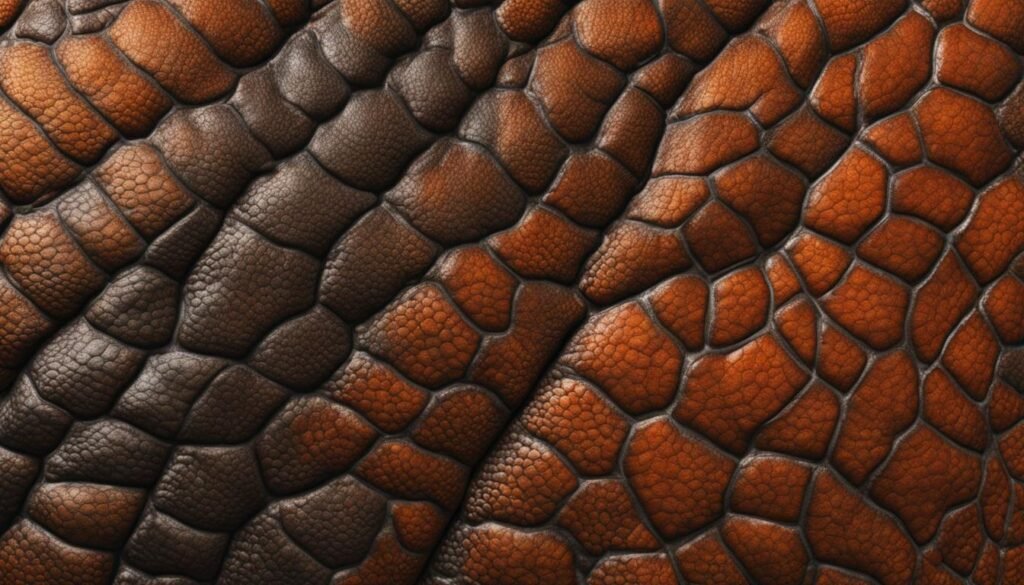
| Dinosaur Species | Skin Texture |
|---|---|
| Tyrannosaurus rex | Smooth |
| Stegosaurus | Bumpy (with bony plates) |
| Triceratops | Rough (with horned structures) |
Molting and Skin Renewal
Dinosaurs, like their modern reptile counterparts, underwent a process known as molting, where they shed their old skin and regenerated new skin cells. This process was essential for the growth and adaptation of dinosaurs to their changing environment. Molting allowed for the renewal of skin and the shedding of damaged or worn-out layers, ensuring that dinosaurs maintained healthy integumentary systems.
Regeneration and Metabolic Functions
The regeneration of new skin cells during molting played a crucial role in the metabolic functions of dinosaurs. As they molted, dinosaurs shed not only their old skin but also any parasites or bacteria that may have accumulated. This renewal process helped dinosaurs stay healthy and free from infections, allowing them to continue growing and thriving.
Additionally, molting provided an opportunity for dinosaurs to adjust their skin and adapt to changes in their environment. For example, during the molting process, dinosaurs could shed their old skin to reveal a new layer with enhanced camouflage patterns or pigmentations that better suited their surroundings. This adaptation allowed dinosaurs to better blend in with their environment and avoid predation.
The Growth Cycle of Dinosaurs
The molting process in dinosaurs was closely tied to their growth cycle. As dinosaurs grew, their skin would stretch and become tight, indicating the need for new, larger skin. Molting allowed dinosaurs to shed their old, constricting skin and replace it with new, more elastic skin that accommodated their increasing size. This growth cycle, facilitated by molting, ensured that dinosaurs could continue to develop and adapt as they progressed from juveniles to fully grown adults.

| Molting and Skin Renewal in Dinosaurs | Key Points |
|---|---|
| Process | Molting involved shedding old skin and regenerating new skin cells. |
| Regeneration | Molting facilitated the regeneration of healthy skin cells, ensuring the continued growth and adaptation of dinosaurs. |
| Metabolic Functions | By shedding old skin, dinosaurs could rid themselves of parasites and bacteria, maintaining their overall health. |
| Adaptation | Molting allowed dinosaurs to adjust their skin to better suit their environment, enhancing camouflage and protection. |
| Growth Cycle | Molting was closely linked to the growth cycle of dinosaurs, providing new, larger skin as they grew in size. |
Ultraviolet Protection and Camouflage
Dinosaur skin may have provided protection against harmful ultraviolet (UV) radiation from the sun. Pigment cells in the skin could have acted as a natural sunscreen, shielding dinosaurs from excessive UV exposure.
In addition to UV protection, the coloration and patterns of dinosaur skin could have served as camouflage, helping them blend into their surroundings and avoid predation.
By camouflaging their appearance, dinosaurs could have increased their chances of survival by making it more difficult for predators to spot them. This adaptation allowed them to effectively hide in their environment, whether it be in lush vegetation or rocky landscapes.

Camouflage in Action
One of the most famous examples of dinosaur camouflage is exhibited by the dinosaur species called Tyrannosaurus rex. This powerful predator had a combination of colors on its skin, including a mottled pattern of dark and light patches. This pattern would have helped break up its silhouette and make it less noticeable to potential prey.
“Camouflage played a crucial role in the survival of dinosaurs, allowing them to evade predators and ambush unsuspecting prey.”
Other dinosaurs, such as the herbivorous Triceratops, may have had skin coloration that allowed them to blend into their surroundings while foraging for plants. This would have allowed them to avoid attracting the attention of predators while they fed.
| Dinosaur Species | Camouflage Adaptations |
|---|---|
| Tyrannosaurus rex | Mottled dark and light patches on skin |
| Triceratops | Blending with the environment through coloration |
| Velociraptor | Striped pattern on skin for disruptive coloration |
These examples illustrate the diverse strategies that dinosaurs may have employed to enhance their survival through UV protection and camouflage.
Conclusion
In conclusion, the study of dinosaur skin provides valuable insights into their appearance, adaptations, and behaviors. Fossilized skin impressions and preserved skin structures reveal the presence of scales and feathers in different dinosaur species. The coloration of dinosaur skin, determined through fossilized melanosomes, suggests a range of colors but predominantly shades of brown, grey, and green for camouflage.
The texture, elasticity, and functions of dinosaur skin served various purposes, including thermoregulation, protection, sensory perception, and haptic feedback. Scales and feathers helped dinosaurs regulate their body temperature, while also providing a defense against predators and environmental hazards. Skin adaptations such as sensory receptors allowed dinosaurs to detect their surroundings, and waterproofing properties protected against water loss.
Understanding dinosaur skin helps us paint a more accurate picture of these fascinating creatures that once roamed the Earth. From their molting and skin renewal process to their ultraviolet protection and camouflage abilities, dinosaur skin played a crucial role in their survival and adaptation. By analyzing and studying the intricacies of dinosaur skin, scientists continue to uncover new discoveries and gain a deeper understanding of these ancient beings.






